Bonnie DeVarco: Margaret
Corbit From Cornell University Theory Centre -- Queenbee
Bonnie DeVarco: Will be speaking about
Bonnie DeVarco: Founding a Virtual Science Center
queenbee: Bonnie, do we want to start now?
Bonnie DeVarco: Sure everyone come on in
queenbee: Hi, I'm Margaret Corbit, the science writer at the Cornell
Theory Center (CTC). Coming to you today from Ithaca, NY in upstate New
York. I will be telling you a bit about our plans to launch a virtual
science center in Active Worlds.
queenbee: Before we get going, let's set some ground rules for
the session. I am going to type in chunks of text in short blocks. We
get about 220 characters to a chat line, so sometimes it will take me
more than one to finish a thought :>)
digigardener: hello margeret corbit
queenbee: Hi Bruce! Thanks for stopping by.
digigardener: please log your chat
Bonnie DeVarco: i am doing it too
queenbee: done!
halebopp: hello all
queenbee: Ok on we go
queenbee: There are four panels behind me with images. The three
to your right have slides on them that will change during my talk. So,
I think it will work best if I go through the content of three slides
at a time.
queenbee: Once I am done telling you about these topics, I will
ask at least one question. Then it's your turn to chime in! We'll let
your comments and questions accumulate in the chat box and then I will
respond.
queenbee: Then we'll change the slides and continue on with the
talk. I hope you will have lots of ideas to share or questions to ask
as we go along.
queenbee: However, it's really easy to digress on technical issues,
so I want to ask you to contact us at AW@tc.cornell.edu with details after
the session. That way we can try and keep on track for our time slot
queenbee: I have put up a series of Web pages with the slides for
the talk. You can pull them up in your Web window by clicking on the right
hand "WebLink" object at the side of the speakers platform.
queenbee: If you are going to use these slides, please load the
first page now. How about if you jump or wave once you got the page loaded?
Cuzminnie: So you get to the protein folding page?
queenbee: Are you getting the same image as the one on your left
in the front
ALSUN: Where do you click to load the page?
queenbee: Sorry, try the other pod
Cuzminnie: No, I'm getting a protein folding page.
queenbee: Pods are silver Web Links on either side of the page.
Cuzminnie: That did the trick, thanks queenbee
queenbee: one sec, I'll fix the page :>)
Actinaut: hi yall
queenbee: Ah well, a few kinks, we'll be off in a second.
drizldrazl: Hello actinaut
queenbee: got it. Now try the link at the right of the stage!
queenbee: Click the next button and you'll get to a copy of the
ground rules. We'll go on from here. When it's time to look at the next
slide, I'll type "(NEXT)" in the chat window. Any questions or suggestions
now?
Immigration Officer: POD3 has moved directly to 40N 0W for chat
isolation, join the discussion there now
queenbee: Thanks for your patience
icey: welcome
mjson: ah, pants
queenbee: welcome all. OK, here we go.
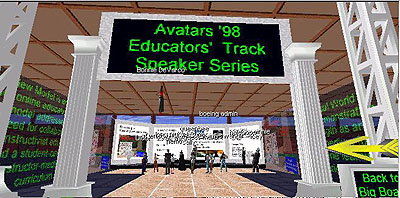
queenbee: (NEXT) A little background -- CTC is the high-performance
computing and communications center at Cornell University. We specialize
in simulations of systems ranging from the Universe to molecules, thus
the name "Theory".
Immigration Officer: Concession stand is open, hotdogs for Only $1, big
lines forming
queenbee: We have supercomputing systems and we do scientific visualization.
We use an immersive "CAVE"-like environment and lots of desktop resources
for imaging. That's how I got hooked on 3D.
Sajinka: hi :-)
Grendel: hi
queenbee: welcome
queenbee: As the science writer, I tell stories about the research
that people do using our resources. The researchers see 3D files and when
the Web came along, I jumped at the chance to share these files with the
general audience.
queenbee: My logic: If a picture is worth a thousand words, then
3D files have to be nearly priceless. I expanded this quest (not a totally
satifying one yet, of course) to virtual worlds.
Immigration Officer: AV98 Radio is now broadcasting, click on the
microphone at GZ
queenbee: (NEXT) I am working with a small team of undergraduate
programmers and designers to create a virtual science center. We have
gotten a lot of help from the folks with the Contact Consortium and Circle
of Fire.
Immigration Officer: AV98 Radio requires Realplayer G2, turn off
your wav file playing under Options
queenbee: We call our world SciCentr. You can see it on the list
now, but we aren't open for business yet. You can read about our vision
for SciCentr at the URL http://www.tc.cornell.edu/Exhibits/Worlds/description.html
queenbee: If there are any questions or comments now, I'll take
them while we change the slides. Thoughts?
sally: what is cave like environment? Actinaut: What is the primary
goal of program? long night: why are you exclusively using undergrads?
queenbee: Great questions, thanks! A CAVE is a room where you can
get inside of 3D files, wear a helmet, even move things around.
nemo: does your team get course credits? is there a workshop?
Cuzminnie: What specific scientific disciplines do you plan on
pursuing in thi senvironment?
queenbee: We run it with a supercomputer and do things like docking
small molecules to large ones
queenbee: computational chemistry, finance, anything with large
3D files of data.
queenbee: OUr primary goal is research communication, we use web
sites, etc, instead of releases to share what goes on here.
queenbee: We use undergrads, because they want to learn how to
do this work. The come as interns and as paid programmers
queenbee: any more questions?
long night: grads don't want to learn then? okay
nemo: what sort of design problems do you encounter?
ALSUN: What's your favorite project?
Cuzminnie: Just a comment: Margaret Geller at Harvard is investigating
the large-scale structure of the universe. This woul dbe a great tool
to help her visualize!
queenbee: grads, do want to learn. I hope to work with grad programmers,
and evaluators soon.
queenbee: right. on Margaret Geller, I have worked with other universe
fols, as well and we would love to run a real model
queenbee: most of your questions now relate to the next slides,
so I'll move on.
Cuzminnie: That would be fantastic, especially in a cave environment.
queenbee: (NEXT) Here's a short mission statement: "Imagine a Virtual
Science Center (SciCentr) founded in a parallel dimension, built by and
for the worldwide community of avatars, or virtual beings.
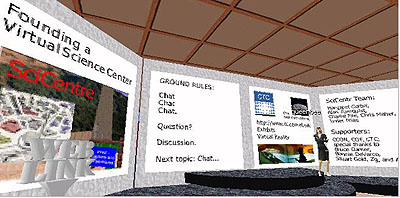
queenbee: A place where you can swing on a star or explore the
atomic maze of a complex molecule.
queenbee: SciCentr will be a meeting place, a workplace, and a
showcase for the power of the Internet as a medium for informal science
education aimed toward teens and young adults."
queenbee: a quick note here about informal science education
queenbee: Informal science education can be defined as extracurricular
education that is self directed and self motivated--no grades, no credit,
no degree. "Edutainment" is a good word for it. And handson science centers
are great places for it
queenbee: The first incarnation of SciCentr will be modeled after
a cross between the 1939 World's Fair and a traditional science center.
But there is no reason to constrain things within these models, this is
just a jumping off point.
queenbee: We chose the 1939 World's Fair because it represents
so much to so many people. To me, it's the premiere for a new medium,
TV, and a symbol for optimism toward technology--directly linked to the
Wizard of Oz!
queenbee: And to cartoons (Merry Melodies, I think) of mice getting
assembly line haircuts and lining up to buy tickets for romantic spaceship
rides to the Moon. Fun, futuristic, portentous.
queenbee: I am an animation freak :>)
queenbee: The molecule you see floating among heads was the first
view of SciCentr. SciCentre looks different now, but I find something
evocative about this view that I would like to it explore further.
queenbee: (NEXT) A traditional science center typically has a strong
community of supporters. There are sponsors for exhibits and programs,
educators, architects, exhibit designers, guides, technical staff, managers,
advisors, and evaluators.
queenbee: If we want to have a healthy, growing world, we will
need to build a similar community to support SciCentr. This is always
on my mind.
queenbee: Right now our community of founding "members" includes
architects, an exhibit designer or two, our guinea pig scientists, a science
education professor,...... and there is a social anthropologist watching
over my shoulder as I type!
queenbee: We're giggling.
queenbee: Evaluation will be an important component of the world
and exhibit development processes. Particular research areas of interest
include interactive exhibit design and the effect of role-playing on the
visitors experience.
queenbee: and that's just for SciCentr. Virtual Worlds have unlimited
research possibilities.
queenbee: We are now experimenting with the medium and a prototype
world as a proof of concept. We are starting to mesh layout and design
with content areas.
Actinaut: anonymous role play?
queenbee: definitely and influence of sex of avatar on behavior.
queenbee: I greatly admire the carefully organized approach that
folks like Bonnie Devarco take in building a world, and I hope to learn
from her example. However, our concept is growing and changing as we go.
queenbee: And we still are at the bottom of the learning curve
;>)
queenbee: We want to build a world where people can explore spaces
devoted to different fields of research conducted at Cornell. Some are
pretty esoteric.
ommm: hi nemo, sally
queenbee: For each exhibit, a team of student builders and programmers
will work with me and consult with researchers. We will try and get an
interesting angle on the science and come up with an innovative way of
communicating about it.
queenbee: these students will range from K-12 to grads. Faculty
and community members, whoever can contribute.
queenbee: If we are lucky, we will also be working with teams of
high school students who will be giving us feedback on our work and also
designing their own exhibits.
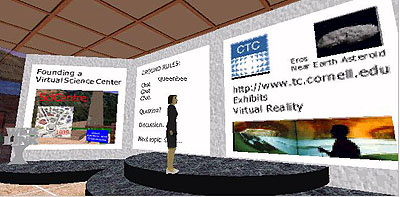
queenbee: (NEXT) As I mentioned earlier, we have experience with
3D on the Internet, but we have focussed on VRML. Virtual Worlds offers
a whole new set of options and challenges. We plan to integrate the two
queenbee: I have worked with a number of student programmers and
CTC staff for more than 3 years now developing a series of outreach science
communication Web sites.
queenbee: We have always tried to stay at the bleeding edge of
the technology. Sometimes it works:>) The sites have each incorporated
3D scientific visualizations.
queenbee: Rock and Roll is from an ongoing project, InDepth. The
next feature to launch includes a 3D CT scan file of a portion of a lung.
queenbee: You have a list the URLs on the slide. All are designed
for Netscape :>)
queenbee: Any questions or comments before we move on?
nemo: you seem very optimistic about the new medium. any concerns
about the concept of "edutainment?"
Actinaut: what strategy for specific objectives and guidance vs.
constructive autonomy?
sally: don't you need an instructional designer in the mix?
drizldrazl: What is your experience teaching younger students to
use the development tools?
zg: are you planning to introduce functionality into aw or run
parallel with your existing VRML development?
queenbee: ok, lots of good questions.
queenbee: A key point is the question of instructional design.
This is edutainment "".
queenbee: We can coordinate with curriculum designers, but our
work really falls within the realm of what NSF, for example, calls Informal
Science Education.
queenbee: We will be working with experts in design of exhibits
by and for young adults, and with Eric Pyle, whose area of expertise is
adolescent learning. queenbee: as for VRML and worlds. We want
to do both, You may know that VRML is on some pretty shaky ground as a
standard.
zg: indeed - but it has functionality aw lacks
queenbee: So I am not wedded to it or any other technology, in
fact, we had a student write a multiuser Java applet 3D two years ago.
queenbee: Virtual Worlds captivated me the first time I saw them.
Especially AW. I would like to contribute to enhancing it.
queenbee: As soon as I learn my way around! We are just studying the
programming now.
queenbee: Did I answer your questions well enough?
zg: can i ask if aw is your preferred route dorward?
zg: forward - sorry
Immigration Officer: This is a good opportunity to thank Bruce
Damer (Digi) for his tireless efforts in putting this event together.
Not many other people could have done it. (Core team CCON)
queenbee: This one will definitely benefit from some user evaluation,
but the models are great!
Cryonics: I am sorry Queenbee I missed you answer from zg, my browser
had a hicup, could you repeat it please
queenbee: We developed this site as an outreach tool for our Parallel
Processing Resource for Biomedical Scientists funded by the National Institutes
of Health. These NIH researchers are some of our biggest users.
zg: :0)
queenbee: Two undergraduates, Alan Turnquist and Andy Heberle wrote
the models last summer; they are based on supercomputer simulation results
and lots of math.
queenbee: The content of this site will be the core of the first
exhibit in SciCentr. Alan is now studying up on bots and C programming
so that we can integrate the models with an exhibit in SciCentr
queenbee: The models will come up in the Web window. We are now thinking
about how to engage avatars into exploring the models. We also want to
try things like creating a multiuser space where avatars can build molecules.
queenbee: (NEXT) SciCentr exhibits will not focus on basic scientific
concepts in the same way that traditional science centers often do. Instead,
our mission is to get people excited about current research topics.
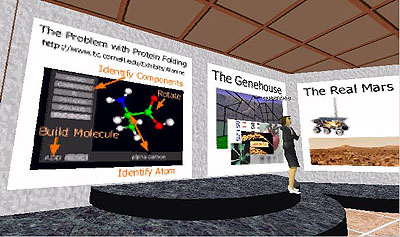
queenbee: For example,
we plan to relate esoteric research like genome mapping to the foods on
your kitchen counter. So in this case, we will use a greenhouse as the
setting--shades of Epcot!
queenbee: It is so much fun to imagine research greenhouses off
to the side of the exhibit house where people can "breed" plants and watch
the process queenbee: It takes a lot of hard work to get the right characteristics
in a new plant. And it's easy to imagine a program that would spew out
all the garbage along with the key cross. Let people sort for themselves!
queenbee: Maybe the Biota folks could help........ Just one of
so many ideas.
queenbee: (NEXT) Maybe we are naive, but we would like to take on
another challenge, one much more intensive in terms of virtual world building.
A little bit of the planet Mars--to spec!
queenbee: In this area of SciCentr, the modular ground will be
based on the topography of a small area on Mars, from Pathfinder data.
Cornell/NASA astrophysicists will provide us the data, which is being
prepared by the USGS.
queenbee: The challenge here is to reach a compromise between the
real data and the limitations of file size and complexity. Then we would
like to add an animated Sojourner Rover bot and a bunch of interactive
features.
queenbee: So this gives you an overview of what we hope to do.
Any questions or suggestions on how we can accomplish this? Volunteers?
mjson: what is the main weakness of AW for your purposes?
zg: Cryonics may be able to correct me on this, but I beleive that
Circle of Fire have already built a geographically corrct protion of Mars
- is there value in repeating the excercise?
queenbee: The one thing that I have encountered so far is that
you don't seem to be able partition the space at will.
zg: can you explain what you mean by partitioning the space?
Cryonics: actually we have not done it for Mars ZG but of the moon
using a topographical photograph of the moon surface and a terrain generator
program we have
queenbee: For example, I would like to set a volume where users
could move things around and it would all go bck to
zg: I stand corrected
queenbee: an initial state when they left.
zg: ok - i understand
Actinaut: here here on the auto reset zg: that is possible
Cryonics: queenbee, that is actually possible now with the SDK
queenbee: Well of course! like I said, we're still starting up. And
I am still struggling to get funidng to make this thing takeoff:>)
zg: so - if that difficulty is overcome, would you say that aw was
the perfect deliver mechanism for your concepts?
queenbee: Everyone has been great so far supporting our effort.
Actinaut: can individuals "carry " variables with them?
zg: that is possible with the SDK i believe - within the same world
queenbee: As for AW being the perfect medium, I couldn't say definitively,
becauser I don'k know enough yet, but it certainly is the best thing I've
seen
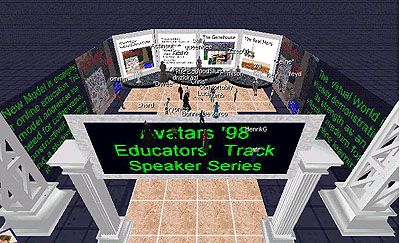
queenbee: and I have
impressed some pretty sophiticated folks when I show it to them
zg: are there any other difficulties you se with aw - apart from
the partitioning of space problem?
queenbee: I guess the rest of the problems we have encountered
so far are more organizational than technicla. A dynamic mapping program
would be nice, though for organizing/
QB: I am curious about the distinction between formal and informal
science education...formal can be entertaining...informal isn't just frivolous...why
separate the two?
zg: hmm - - i believe that is available
Actinaut: a log of previous actions that affect the next situation
- specific to the indiv (custom branching)
Actinaut: back to variables that is...
zg: actinaut - again that is in the SDK
queenbee: Great, Alan and Chris, are you getting this? :>)
"Chris": yes
drizldrazl: To change the subject. Any thoughts on evaluation of
the effectiveness of the educational value of the edutainment?
Actinaut: help file didnt seem to cover thta shal i look again?
feyd: yup. ;) For all of you, I'm Alan.
zg: hi feyd
Cryonics: Actunaut, you will actually be able to see such an implementation
of a bot remembering a users previous action and acting accordingly in
a new world we will soon be opening called the 13th floor
queenbee: Informal science education is driven more by the audience
than the provider. The goal is to empower and engage, more than to share
specific units of knowledge.
Actinaut: thanks way to stay ahead :>
zg: the SDK is a very powerful addition to Active Worlds
Grendel: I would hope that formal education would have the same
goal these days! :-)
Actinaut: we can go to learning not just chat !
feyd: yes, the SDK solves al great many things.
queenbee: Evaluation of what people learn through these programs
is critical, but the funding agencies and museums, etc. seem more concerned
about changes in attitude toward science than knowledge
sally: that is kind of limiting isn't it?
queenbee: the point being that if people are afraid or suspicious
of science, they won't pursue it.
zg: how do you plan to evaluate what people learn?
queenbee: limiting, no actually, for me it's liberating since I don't
have a degree in education.
drizldrazl: What type of input are these groups looking for to
determine a change in attitude. Can these be refleced online at the AW
site?
queenbee: We plan to hook up with a team that professionally evaluates
science museum exhibits and have them work with us from the start.
Immigration Officer: When you enter AV98 click on BigBoard to teleport
and see the schedule of speakers
queenbee: We will also have folks doing research on evaluation
methods for themedium. It's really different afterall.
Cuzminnie: That's an excellent idea
queenbee: Thanks
zg: would it help if the evaluators had some experience of the
medium?
Zeke: *and Zeke appears ... and falls on his face*
Little Cupid: LOL
drizldrazl: Children science museum's often have collaborative
events, any thoughts on this at your site?
Cuzminnie: It's important for new users to have a familiar model
that allows them ease of access into a new technology.
dZap: hej Dan
Zeke: I got to get this teleport thing right-side up ... LOL
Zzap01: have you considered digging up some other funding that
might relate to your interests?
Danny Swede: tjena Jonas
Actinaut: QBEE - good VIRT BLURT, Ill check out your website and
good luck (i'm gone...)
dZap: join'a mig igen, Dan
queenbee: We want science fairs, and handson labs. We hope to get
different programs sponsored by differernt orgs.
Zzap01: i'm sitting at the franklin institute in philly, and we're
working on business learning tools - spoinsored by darpa and such...
Cuzminnie: What orgs are you currently pursuing funding-wise?
zg: and will these different programs be AW based?
HenrikG: qb.. appealing designs might help make people feel comfortable
with science
queenbee: right now, i need a balloon bigger than CTC to float
us. WE do get funds from NIH, Dod, NSF, Cornell, NYS, etc.
queenbee: So far, that's what pays my salary:>)!
zg: one of the main advantages of aw is that development is cheap
and quick
Cuzminnie: Sounds good to me! Any private sector interest?
zg: compared to other forms of virtual reality
Bonnie DeVarco: And the learning curve for students is very fast
queenbee: right, and we have to be quick now. It's time to wrap
up and move on.
Twinkle: Discussion about using Virtual Worlds for providing information
for future university students starting soon in 'BOWorld'
Twinkle: If your interested, please teleport to 'BOWorld' now
Bonnie DeVarco: Student Panel now on some of these very issues
will now follow Margaret,
queenbee: Students are amazing creatures. I couldn't do anything
without you guys. thanks and thanks to all of you
Bonnie DeVarco: Margaret, this is a very exciting direction you
are going in.
ommm: brava, QB
nemo: thanks, qb!!
Twinkle: The discussion will be hosted by Dr. Drs. Jan A.W. de
Bruin if the Tilbrug University
mjson: clap, clap
comfortably numb: thanks qb!
drizldrazl: LOL
Bonnie DeVarco: let's all wave an ovation
HenrikG:
Little Cupid: Woooohooo QB!!! Sorry I only got the end of it *sigh*
ommm: wave, wave
Little Cupid: *waves*
kyzla:
Twinkle:
Bonnie DeVarco: Remember the urls
queenbee: you're all terrific, keep in touch.
Cuzminnie: Way 2 go qb comfortably numb: remember the av actions
Bonnie DeVarco: This discussion will be posted on the CCon page
in a couple days
Cuzminnie: Excellent
The Bob: Thanks Queenbee. (Hi, Tammy) :)
Little Cupid: My *wave* button didn't work :-(((
Bonnie DeVarco: Yes, Thanks Queenbee.
zg: thanks - very illuminating
| ABOUT
MARGARET CORBIT: "As a member of the staff at the Cornell Theory Center(CTC), I research and write articles describing many aspects of the science conducted at and/or supported by the CTC for our online publications. In addition, I coordinate the development of the online informal science education sites which include our online science books and special online exhibits. I am also a member of the team developing an integrated, Web-based GIS system for New York State's Empire State Development office." http://www.tc.cornell.edu/~corbitm/ |